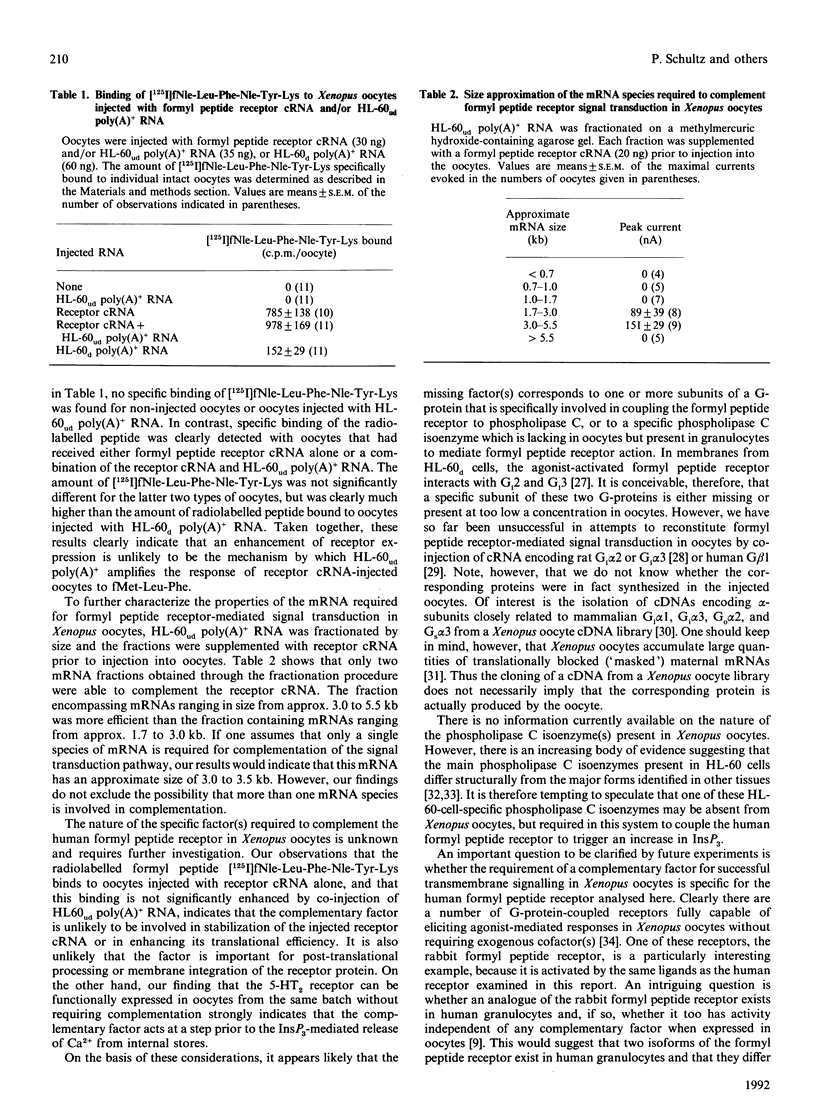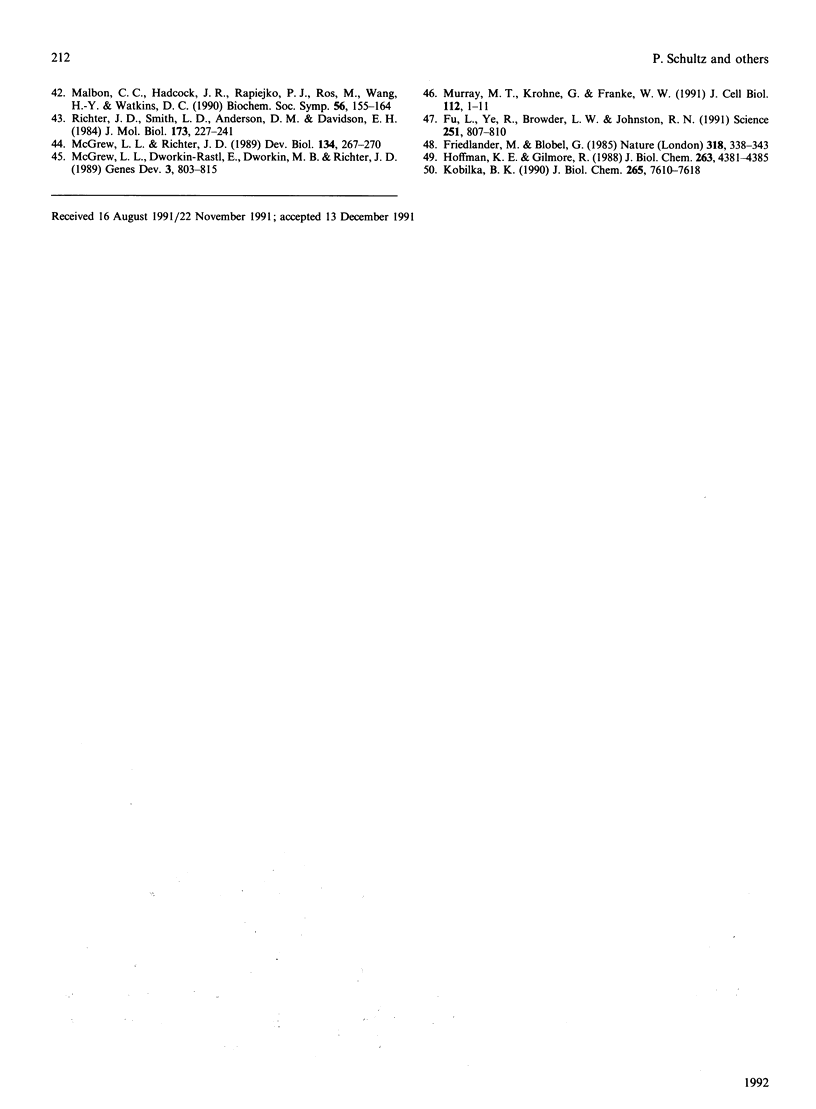Abstract
Formyl-methionine-containing peptides (e.g. fMet-Leu-Phe) stimulate a variety of neutrophil functions by interacting with specific cell surface receptors which are coupled via G-proteins to stimulation of phospholipase C. Two markedly distinct cDNAs coding for formyl peptide receptors have recently been isolated from a rabbit and a human cDNA library respectively. To examine the hitherto unknown signal transduction properties of the formyl peptide receptor encoded by the human cDNA, we have used the PCR to clone this cDNA from poly(A)+ RNA of myeloid differentiated human leukaemia (HL-60) cells, and have injected the cDNA-derived receptor cRNA into Xenopus laevis oocytes. Receptor activity was determined electrophysiologically by measuring the agonist-dependent opening of intracellular Ca2+ concentration ([Ca2+]i)-independent Cl- channels. Injection of pure formyl peptide receptor cRNA did not lead to peptide-dependent changes in membrane current. In contrast, marked alterations of membrane current were observed in response to formyl peptides when the receptor cRNA was supplemented with poly(A)+ RNA isolated from undifferentiated HL-60 cells. Injection of the latter RNA did not lead to formyl-peptide-dependent alterations of membrane current. Binding studies using a radioiodinated formyl peptide revealed that injection of formyl peptide receptor cRNA alone led to expression of the formyl peptide receptor on the oocyte surface, and that co-injection of poly(A)+ RNA from undifferentiated HL-60 cells did not alter the level of receptor expression. Size fractionation of poly(A)+ RNA from undifferentiated HL-60 cells showed that the mRNA required to complement formyl-peptide-dependent signal transduction in oocytes had a size of approx. 3-3.5 kb. These results strongly suggest that the human formyl peptide receptor requires a specific cofactor(s), which is lacking in Xenopus oocytes but is present in undifferentiated HL-60 cells, to activate the second messenger pathway in oocytes. Identification of this factor will provide important information about the molecular mechanisms by which G-protein-coupled granulocyte-activating receptors stimulate phospholipase C.
Full text
PDF





Selected References
These references are in PubMed. This may not be the complete list of references from this article.
- Boulay F., Tardif M., Brouchon L., Vignais P. The human N-formylpeptide receptor. Characterization of two cDNA isolates and evidence for a new subfamily of G-protein-coupled receptors. Biochemistry. 1990 Dec 18;29(50):11123–11133. doi: 10.1021/bi00502a016. [DOI] [PubMed] [Google Scholar]
- Böhm M., Larisch K., Erdmann E., Camps M., Jakobs K., Gierschik P. Failure of [32P]ADP-ribosylation by pertussis toxin to determine Gi alpha content in membranes from various human tissues. Improved radioimmunological quantification using the 125I-labelled C-terminal decapeptide of retinal transducin. Biochem J. 1991 Jul 1;277(Pt 1):223–229. doi: 10.1042/bj2770223. [DOI] [PMC free article] [PubMed] [Google Scholar]
- Chaplinski T. J., Niedel J. E. Cyclic nucleotide-induced maturation of human promyelocytic leukemia cells. J Clin Invest. 1982 Nov;70(5):953–964. doi: 10.1172/JCI110707. [DOI] [PMC free article] [PubMed] [Google Scholar]
- Chee M. S., Satchwell S. C., Preddie E., Weston K. M., Barrell B. G. Human cytomegalovirus encodes three G protein-coupled receptor homologues. Nature. 1990 Apr 19;344(6268):774–777. doi: 10.1038/344774a0. [DOI] [PubMed] [Google Scholar]
- Coats W. D., Jr, Navarro J. Functional reconstitution of fMet-Leu-Phe receptor in Xenopus laevis oocytes. J Biol Chem. 1990 Apr 15;265(11):5964–5966. [PubMed] [Google Scholar]
- Codina J., Stengel D., Woo S. L., Birnbaumer L. Beta-subunits of the human liver Gs/Gi signal-transducing proteins and those of bovine retinal rod cell transducin are identical. FEBS Lett. 1986 Oct 27;207(2):187–192. doi: 10.1016/0014-5793(86)81486-7. [DOI] [PubMed] [Google Scholar]
- Collins S., Caron M. G., Lefkowitz R. J. Regulation of adrenergic receptor responsiveness through modulation of receptor gene expression. Annu Rev Physiol. 1991;53:497–508. doi: 10.1146/annurev.ph.53.030191.002433. [DOI] [PubMed] [Google Scholar]
- Eva C., Keinänen K., Monyer H., Seeburg P., Sprengel R. Molecular cloning of a novel G protein-coupled receptor that may belong to the neuropeptide receptor family. FEBS Lett. 1990 Oct 1;271(1-2):81–84. doi: 10.1016/0014-5793(90)80377-u. [DOI] [PubMed] [Google Scholar]
- Friedlander M., Blobel G. Bovine opsin has more than one signal sequence. 1985 Nov 28-Dec 4Nature. 318(6044):338–343. doi: 10.1038/318338a0. [DOI] [PubMed] [Google Scholar]
- Fu L. N., Ye R. Q., Browder L. W., Johnston R. N. Translational potentiation of messenger RNA with secondary structure in Xenopus. Science. 1991 Feb 15;251(4995):807–810. doi: 10.1126/science.1990443. [DOI] [PubMed] [Google Scholar]
- Gierschik P., Sidiropoulos D., Jakobs K. H. Two distinct Gi-proteins mediate formyl peptide receptor signal transduction in human leukemia (HL-60) cells. J Biol Chem. 1989 Dec 25;264(36):21470–21473. [PubMed] [Google Scholar]
- Gierschik P., Steisslinger M., Sidiropoulos D., Herrmann E., Jakobs K. H. Dual Mg2+ control of formyl-peptide-receptor--G-protein interaction in HL 60 cells. Evidence that the low-agonist-affinity receptor interacts with and activates the G-protein. Eur J Biochem. 1989 Jul 15;183(1):97–105. doi: 10.1111/j.1432-1033.1989.tb14901.x. [DOI] [PubMed] [Google Scholar]
- Hoffman K. E., Gilmore R. Guanosine triphosphate promotes the post-translational integration of opsin into the endoplasmic reticulum membrane. J Biol Chem. 1988 Mar 25;263(9):4381–4385. [PubMed] [Google Scholar]
- Jones D. T., Reed R. R. Molecular cloning of five GTP-binding protein cDNA species from rat olfactory neuroepithelium. J Biol Chem. 1987 Oct 15;262(29):14241–14249. [PubMed] [Google Scholar]
- Kobilka B. K. The role of cytosolic and membrane factors in processing of the human beta-2 adrenergic receptor following translocation and glycosylation in a cell-free system. J Biol Chem. 1990 May 5;265(13):7610–7618. [PubMed] [Google Scholar]
- Krieg P. A., Melton D. A. Functional messenger RNAs are produced by SP6 in vitro transcription of cloned cDNAs. Nucleic Acids Res. 1984 Sep 25;12(18):7057–7070. doi: 10.1093/nar/12.18.7057. [DOI] [PMC free article] [PubMed] [Google Scholar]
- Kriz R., Lin L. L., Sultzman L., Ellis C., Heldin C. H., Pawson T., Knopf J. Phospholipase C isozymes: structural and functional similarities. Ciba Found Symp. 1990;150:112–127. doi: 10.1002/9780470513927.ch8. [DOI] [PubMed] [Google Scholar]
- Lehmeyer J. E., Snyderman R., Johnston R. B., Jr Stimulation of neutrophil oxidative metabolism by chemotactic peptides: influence of calcium ion concentration and cytochalasin B and comparison with stimulation by phorbol myristate acetate. Blood. 1979 Jul;54(1):35–45. [PubMed] [Google Scholar]
- Levitan E. S. Cloning of serotonin and substance K receptors by functional expression in frog oocytes. Trends Neurosci. 1988 Feb;11(2):41–43. doi: 10.1016/0166-2236(88)90159-2. [DOI] [PubMed] [Google Scholar]
- Libert F., Parmentier M., Lefort A., Dinsart C., Van Sande J., Maenhaut C., Simons M. J., Dumont J. E., Vassart G. Selective amplification and cloning of four new members of the G protein-coupled receptor family. Science. 1989 May 5;244(4904):569–572. doi: 10.1126/science.2541503. [DOI] [PubMed] [Google Scholar]
- Lübbert H., Snutch T. P., Dascal N., Lester H. A., Davidson N. Rat brain 5-HT1C receptors are encoded by a 5-6 kbase mRNA size class and are functionally expressed in injected Xenopus oocytes. J Neurosci. 1987 Apr;7(4):1159–1165. doi: 10.1523/JNEUROSCI.07-04-01159.1987. [DOI] [PMC free article] [PubMed] [Google Scholar]
- Malbon C. C., Hadcock J. R., Rapiejko P. J., Ros M., Wang H. Y., Watkins D. C. Regulation of transmembrane signalling elements: transcriptional, post-transcriptional and post-translational controls. Biochem Soc Symp. 1990;56:155–164. [PubMed] [Google Scholar]
- McGrew L. L., Dworkin-Rastl E., Dworkin M. B., Richter J. D. Poly(A) elongation during Xenopus oocyte maturation is required for translational recruitment and is mediated by a short sequence element. Genes Dev. 1989 Jun;3(6):803–815. doi: 10.1101/gad.3.6.803. [DOI] [PubMed] [Google Scholar]
- McGrew L. L., Richter J. D. Xenopus oocyte poly(A) RNAs that hybridize to a cloned interspersed repeat sequence are not translatable. Dev Biol. 1989 Jul;134(1):267–270. doi: 10.1016/0012-1606(89)90097-3. [DOI] [PubMed] [Google Scholar]
- Mullis K. B., Faloona F. A. Specific synthesis of DNA in vitro via a polymerase-catalyzed chain reaction. Methods Enzymol. 1987;155:335–350. doi: 10.1016/0076-6879(87)55023-6. [DOI] [PubMed] [Google Scholar]
- Murphy P. M., Gallin E. K., Tiffany H. L., Malech H. L. The formyl peptide chemoattractant receptor is encoded by a 2 kilobase messenger RNA. Expression in Xenopus oocytes. FEBS Lett. 1990 Feb 26;261(2):353–357. doi: 10.1016/0014-5793(90)80590-f. [DOI] [PubMed] [Google Scholar]
- Murphy P. M., McDermott D. Functional expression of the human formyl peptide receptor in Xenopus oocytes requires a complementary human factor. J Biol Chem. 1991 Jul 5;266(19):12560–12567. [PubMed] [Google Scholar]
- Murray M. T., Krohne G., Franke W. W. Different forms of soluble cytoplasmic mRNA binding proteins and particles in Xenopus laevis oocytes and embryos. J Cell Biol. 1991 Jan;112(1):1–11. doi: 10.1083/jcb.112.1.1. [DOI] [PMC free article] [PubMed] [Google Scholar]
- Niedel J., Wilkinson S., Cuatrecasas P. Receptor-mediated uptake and degradation of 125I-chemotactic peptide by human neutrophils. J Biol Chem. 1979 Nov 10;254(21):10700–10706. [PubMed] [Google Scholar]
- Olate J., Martinez S., Purcell P., Jorquera H., Codina J., Birnbaumer L., Allende J. Molecular cloning and sequence determination of four different cDNA species coding for alpha-subunits of G proteins from Xenopus laevis oocytes. FEBS Lett. 1990 Jul 30;268(1):27–31. doi: 10.1016/0014-5793(90)80964-k. [DOI] [PubMed] [Google Scholar]
- Oron Y., Dascal N., Nadler E., Lupu M. Inositol 1,4,5-trisphosphate mimics muscarinic response in Xenopus oocytes. Nature. 1985 Jan 10;313(5998):141–143. doi: 10.1038/313141a0. [DOI] [PubMed] [Google Scholar]
- Oron Y., Straub R. E., Traktman P., Gershengorn M. C. Decreased TRH receptor mRNA activity precedes homologous downregulation: assay in oocytes. Science. 1987 Dec 4;238(4832):1406–1408. doi: 10.1126/science.2825350. [DOI] [PubMed] [Google Scholar]
- Pritchett D. B., Bach A. W., Wozny M., Taleb O., Dal Toso R., Shih J. C., Seeburg P. H. Structure and functional expression of cloned rat serotonin 5HT-2 receptor. EMBO J. 1988 Dec 20;7(13):4135–4140. doi: 10.1002/j.1460-2075.1988.tb03308.x. [DOI] [PMC free article] [PubMed] [Google Scholar]
- Rhee S. G., Kim H., Suh P. G., Choi W. C. Multiple forms of phosphoinositide-specific phospholipase C and different modes of activation. Biochem Soc Trans. 1991 Apr;19(2):337–341. doi: 10.1042/bst0190337. [DOI] [PubMed] [Google Scholar]
- Richter J. D., Smith L. D., Anderson D. M., Davidson E. H. Interspersed poly(A) RNAs of amphibian oocytes are not translatable. J Mol Biol. 1984 Feb 25;173(2):227–241. doi: 10.1016/0022-2836(84)90191-8. [DOI] [PubMed] [Google Scholar]
- Schiffmann E., Corcoran B. A., Wahl S. M. N-formylmethionyl peptides as chemoattractants for leucocytes. Proc Natl Acad Sci U S A. 1975 Mar;72(3):1059–1062. doi: 10.1073/pnas.72.3.1059. [DOI] [PMC free article] [PubMed] [Google Scholar]
- Showell H. J., Freer R. J., Zigmond S. H., Schiffmann E., Aswanikumar S., Corcoran B., Becker E. L. The structure-activity relations of synthetic peptides as chemotactic factors and inducers of lysosomal secretion for neutrophils. J Exp Med. 1976 May 1;143(5):1154–1169. doi: 10.1084/jem.143.5.1154. [DOI] [PMC free article] [PubMed] [Google Scholar]
- Snyderman R., Pike M. C. Chemoattractant receptors on phagocytic cells. Annu Rev Immunol. 1984;2:257–281. doi: 10.1146/annurev.iy.02.040184.001353. [DOI] [PubMed] [Google Scholar]
- Takahashi T., Neher E., Sakmann B. Rat brain serotonin receptors in Xenopus oocytes are coupled by intracellular calcium to endogenous channels. Proc Natl Acad Sci U S A. 1987 Jul;84(14):5063–5067. doi: 10.1073/pnas.84.14.5063. [DOI] [PMC free article] [PubMed] [Google Scholar]
- Thomas K. M., Pyun H. Y., Navarro J. Molecular cloning of the fMet-Leu-Phe receptor from neutrophils. J Biol Chem. 1990 Nov 25;265(33):20061–20064. [PubMed] [Google Scholar]


